#cute as a bug
Video
youtube
ESA's Airbus Reusable Rocket: The Adeline
17 notes
·
View notes
Text



How does tumblr feel about Primrose
(edit: some folks are asking if this is taxidermy. This is a real living dog, I promise)
#dog#my post#cute dog#dog bather#dog grooming#dog groomer#im torn.#bug eyes#boba pearl eyes#gnarp#primrose#fan fav
55K notes
·
View notes
Text

mimics
#chilchuck#dungeon meshi#delicious in dungeon#dunmeshi#my art#i thought ab coloring it but idk if im up 4 the challenge AHAHA#AND TREASURE BUGSSS#iactually really love the .idk what u would call it. in universe ecology HELPP idk laios facts ab#the bugs laying eggs in the mimics.devouring that thing..and now u have treasure bug chests <3 SOO COOL#and doesnt chilchuck think they r cute or smt :sob:
23K notes
·
View notes
Text
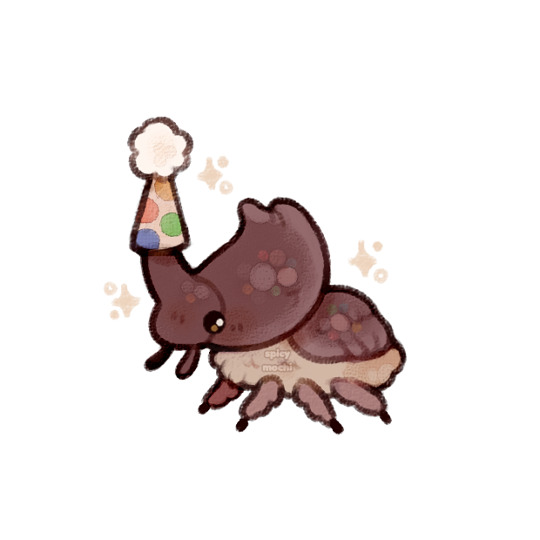
party beetle
#bug#bug art#beetles#artists on tumblr#digital art#my art#art#illustration#drawing#artwork#cute#kawaii#animals#animal art#illust#soft art#nature#rhinoceros beetle#memes#insects
23K notes
·
View notes
Text

someday 🐞
#doodle#sketchbook#cute art#doodles#eggsdoodz#illustrators on tumblr#pencil drawing#art#pencil doodles#healingjourney#it will get better#lady bug
18K notes
·
View notes
Text
Strange Bedfellows: these unprecedented photos show a leafcutter bee sharing its nest with a wolfspider

I stumbled across these photos while I was looking up information on leafcutter bees, and I just thought that this was too cool not to share. Captured by an amateur photographer named Laurence Sanders, the photos were taken in Queensland, Australia several years ago, and they quickly garnered the attention of both entomologists and arachnologists.

The leafcutter bee (Megachile macularis) can be seen fetching freshly-cut leaves, which she uses to line the inner walls of her nest. The wolfspider moves aside as the bee approaches, allowing her to enter the nest, and then she simply watches as the leaf is positioned along the inner wall.
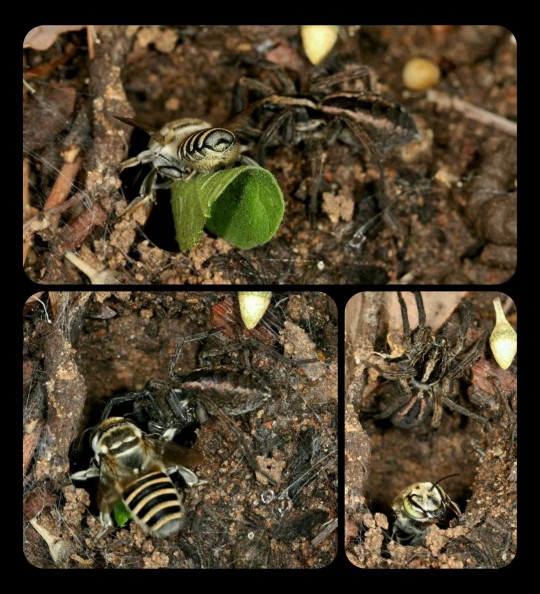
Once the leaf is in position, they seem to inspect the nest together, sitting side-by-side in the entryway; the bee eventually flies off again to gather more leaves, while the wolfspider climbs back into the burrow.
The leafcutter bee seems completely at ease in the presence of the wolfspider, which is normally a voracious predator, and the wolfspider is equally unfazed by the fact that it shares its burrow with an enormous bee.
The photographer encountered this bizarre scene by accident, and he then captured a series of images over the course of about 2 days (these are just a few of the photos that were taken). During that 2-day period, the bee was seen entering the nest with pieces of foliage dozens of times, gradually constructing the walls and brood chambers of its nest, and the spider was clearly occupying the same burrow, but they did not exhibit any signs of aggression toward one another.
The photos have been examined by various entomologists and arachnologists, and those experts seem ubiquitously surprised by the behavior that the images depict. The curator of entomology at Victoria Museum, Dr. Ken Walker, noted that this may be the very first time that this behavior has ever been documented, while Dr. Robert Raven, an arachnid expert at the Queensland Museum, described it as a "bizarre" situation.
This arrangement is completely unheard of, and the images are a fascinating sight to behold.
Sources & More Info:
Brisbane Times: The Odd Couple: keen eye spies bee and spider bedfellows in 'world-first'
iNaturalist: Megachile macularis
#entomology#arachnology#leafcutter bee#wolfspider#symbiosis#cool animals#cool bugs#bees#spiders#nature#cute#insects#arachnids#australia#props to the photographer#laurence sanders#this is a cute couple#but their babies would be terrifying
24K notes
·
View notes
Text









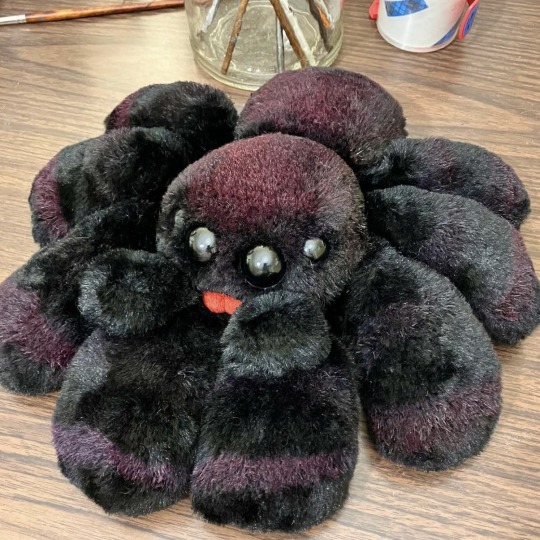


Spider plushies by plaything_co
#spider#spiders#plushies#plushblr#aesthetic#cute#bugblr#bug#bugs#gardencore#cottagecore#grandmacore#goblincore#light academia#plushcore#plush animals#plush community#plush toy#small business#cozycore#cozy#cottage
16K notes
·
View notes
Text

10K notes
·
View notes
Text






never added the final line to one of these mugs before, but I felt it was time for weird bugs
#reserved#pottery#ceramics#ceramic#ceramic art#sgraffito#carving#calvin and hobbes#bill watterson#calvin and hobbes quote#coffee mugs#ceramic mugs#mugs#hand built pottery#frogs#frog#bugs#insects#sow bug I think#I think they’re cute
7K notes
·
View notes
Text

#butterfly#butterflies#diagram#chart#aesthetic#cottagecore#fairycore#science#sciencecore#nature#naturecore#forestcore#forest aesthetic#forest#cottage aesthetic#cute#bugs#bugcore#insects#gif#north america#Butterflies of North America by Brock JP and Kaufman K.#brock jp#kaufman k
8K notes
·
View notes
Text

They're like a packet of fruit snack gummies
#trafficblr#mumbo jumbo#life series#grian#goodtimeswithscar#solidaritygaming#smallishbeans#smajor1995#impulsesv#skizzleman#tangotek#ethoslab#bdoubleo100#zombiecleo#inthelittlewood#rendog#bigbst4tz2#geminitay#pearlescentmoon#yknow i made this for personal use on some later projects but people seem to like my goofy doodle esque style#i apologize to gem and fans of gem because i have done her so dirty here...i didn't know what i wanted with her design...#it's kinda cute? but there's stuff lacking man...#otherwise i'm fairly happy with these#bug eyed freaks /pos#my art#ldshadowlady#<- shameful add on...ty to that one commenter who pointed out that i forgot to tag lizzie 😭
4K notes
·
View notes
Text

#bug#bugs#funny#lol#haha#humor#meme#memes#wholesome#aww#adorable#cute animals#love#aesthetic#cottagecore#photography#nature#landscape#adventure#explore#travel#paradise#travelling
3K notes
·
View notes
Text
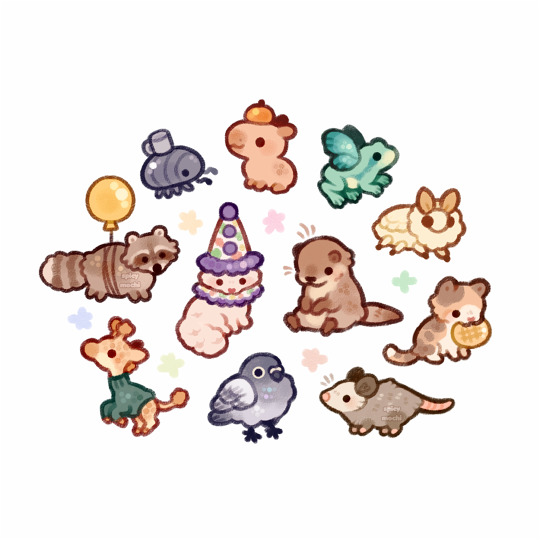
choose your fav mini creature
#otter#possum#raccoon#artists on tumblr#digital art#digital illustration#illustration#my art#art#drawing#cute#kawaii#animals#animal art#illust#soft art#pigeon#cat memes#bug#capybara
24K notes
·
View notes
Text

#cute#aes#aesthetic#pink#girly#kawaii#adorable#pinkcore#bugs#isopods#aww#animals#coquette#dolly#dollette#tw
4K notes
·
View notes
Text
Pill Scarab Beetles: these beetles are covered in plates that perfectly interlock when the beetle folds its limbs, lowers its head, and curls itself into a ball

Above: Eusphaeropeltis sp. (top/bottom left) and Ceratocanthus aeneus (bottom right), two different species of pill scarab beetle
Beetles of the Ceratocanthinae subfamily (also known as pill scarab beetles) rely on a unique form of conglobation to conceal themselves. As the beetle tucks its head down and folds its legs up against its belly, the plates on its head, thorax, abdomen, and legs all come together to form a solid shield; the plates on its legs even have grooves and corresponding ridges that allow them to neatly interlock.

As this blog post explains:
Adult Ceratocanthinae are best known for their ability to conglobate: rolling into a nearly perfect ball. The elytra, pronotum, head, and all six tibiae interlock with each other by means of grooves and corresponding ridges, forming a tightly connected external surface. Many beetles take the form of a tight compact structure when threatened, however in Ceratocanthinae the tibiae of all six legs participate in forming the external hard surface of the sphere, unlike in other beetles.

Above: Ceratocanthus sp.
The Ceratocanthinae subfamily contains many different genera/species, and they are all collectively known as pill scarabs. Many of them have a colorful, metallic appearance; they may be green, red, blue, brown, black, or multicolor.
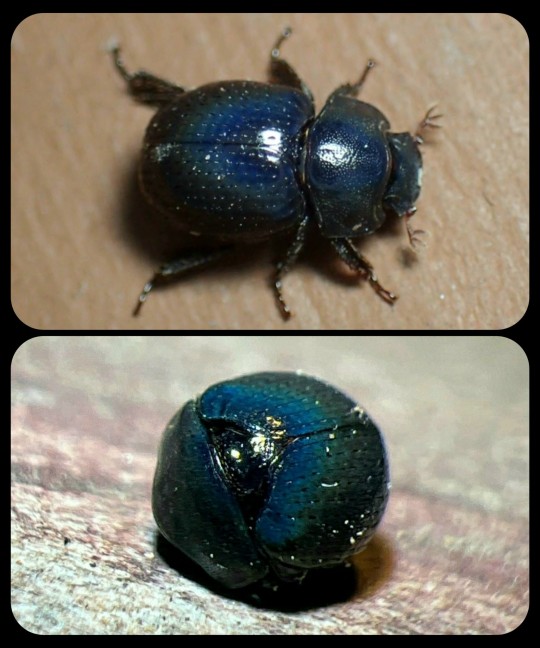
Above: Germarostes globosus
Sources & More Info:
Gil Wizen: Transformers (Ceratocanthinae Beetles)
Communications Biology: The Evolution of Conglobation in Ceratocanthinae
Arthropod Systematics and Phylogeny: Rolling into a Ball: phylogeny of the Ceratocanthinae
ZooKeys: The Ceratocanthinae of Ulu Gombak
Pavel Krásenský Photography: Scarabaeidae (this site is written in Czech)
#entomology#insects#beetles#pill scarab#ceratocanthus#ceratocanthinae#coleoptera#coleopterology#nature#scarabs#Eusphaeropeltis#gil wizen#Pavel Krásenský#cool bugs#cute animals
9K notes
·
View notes
